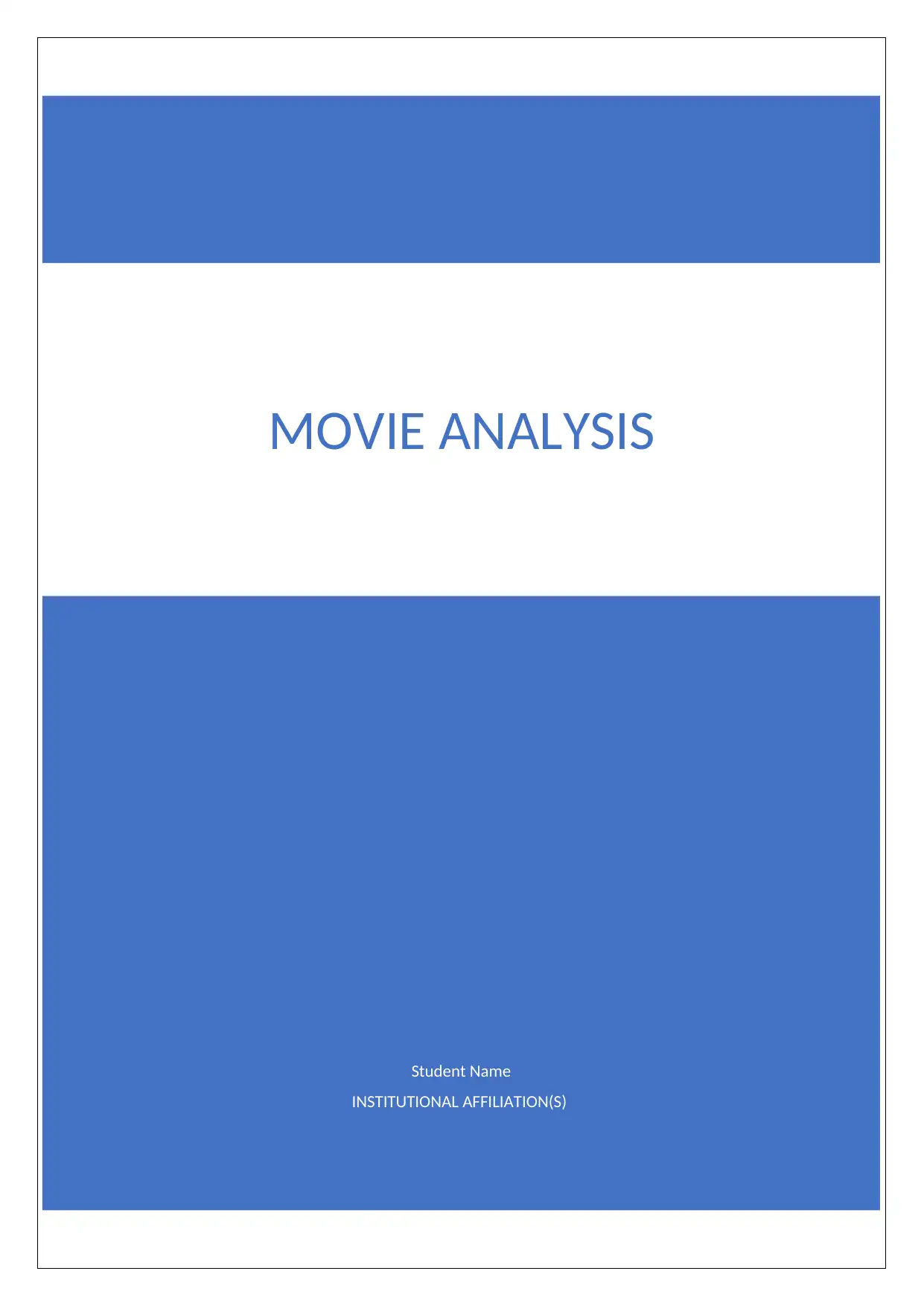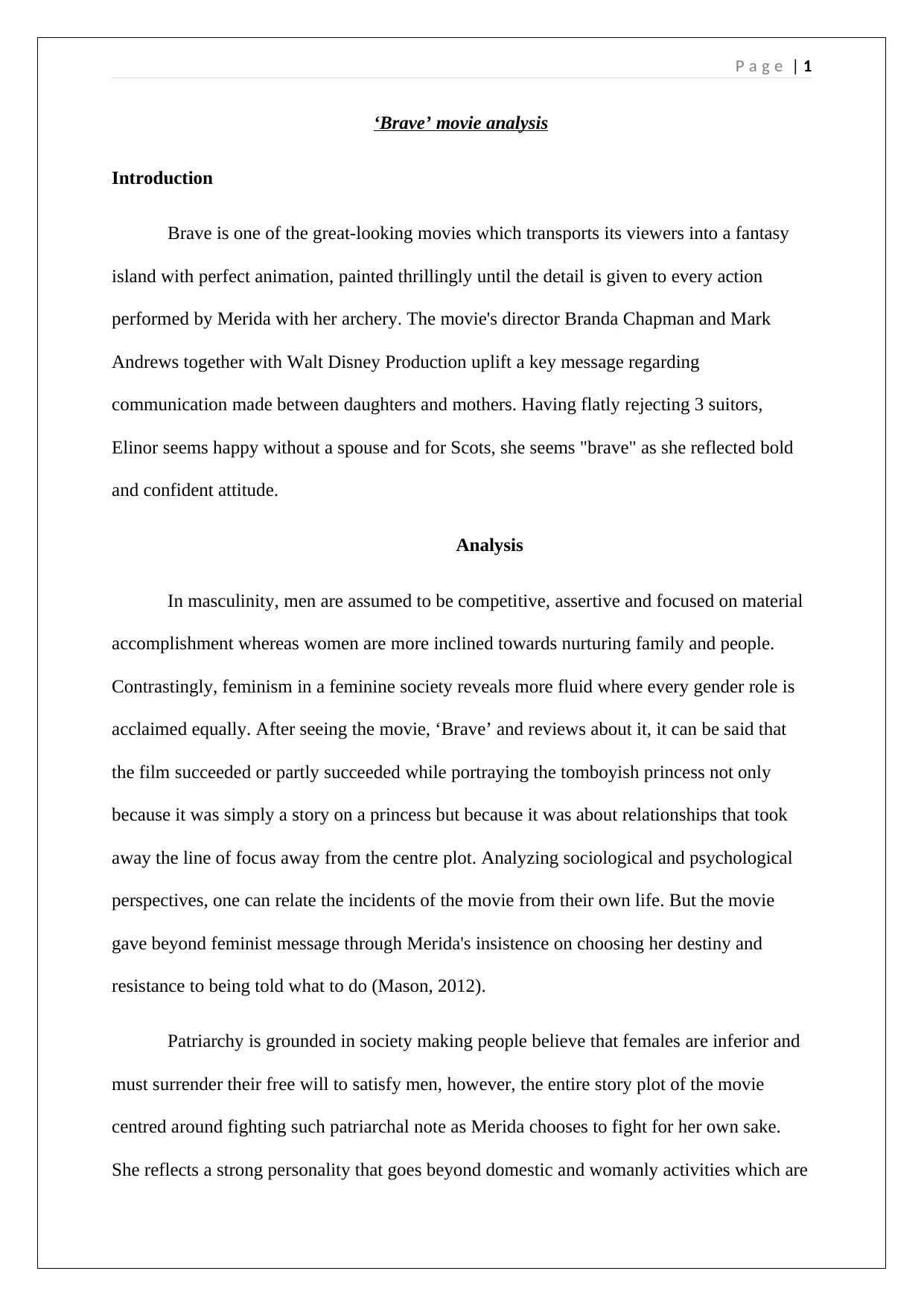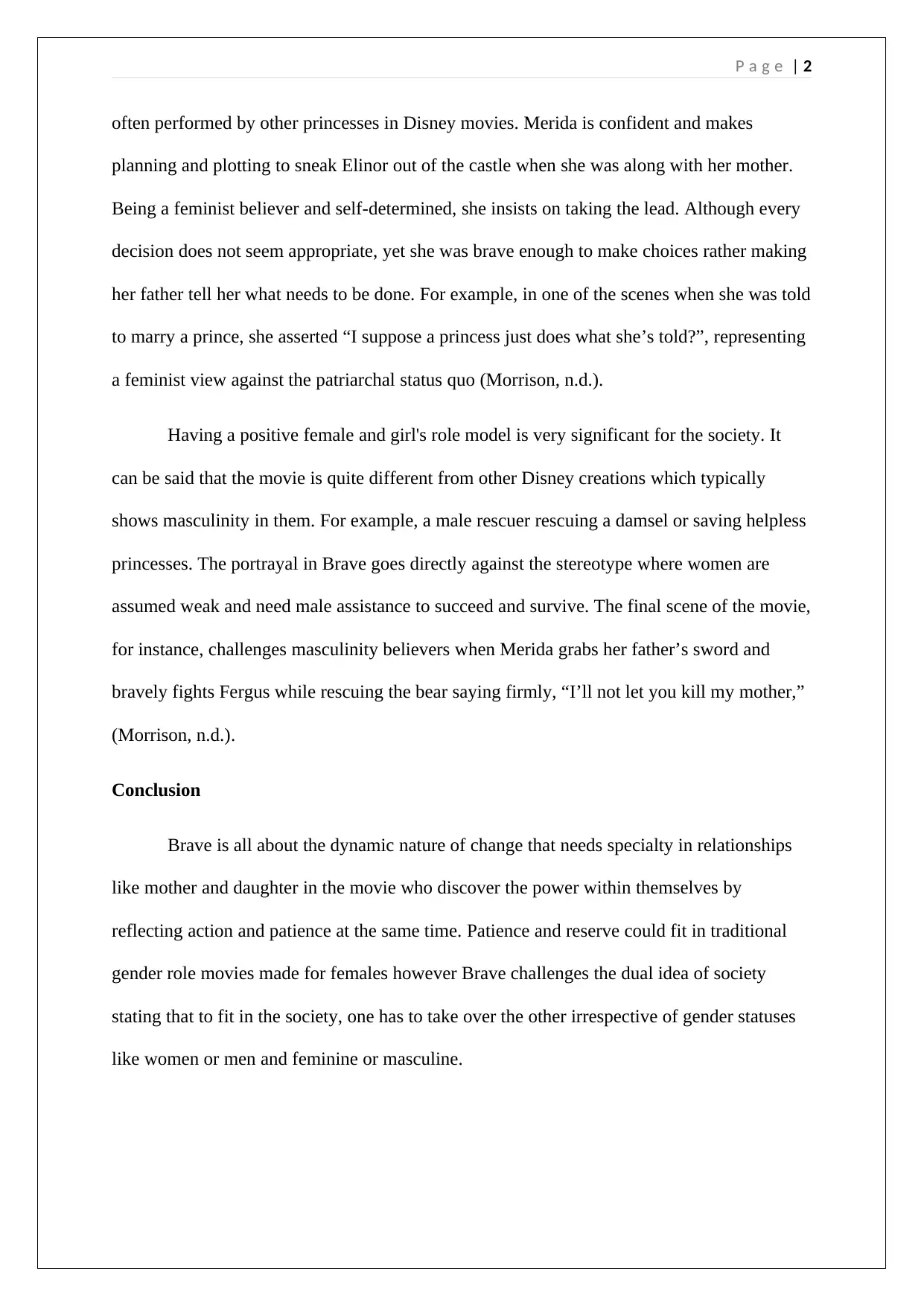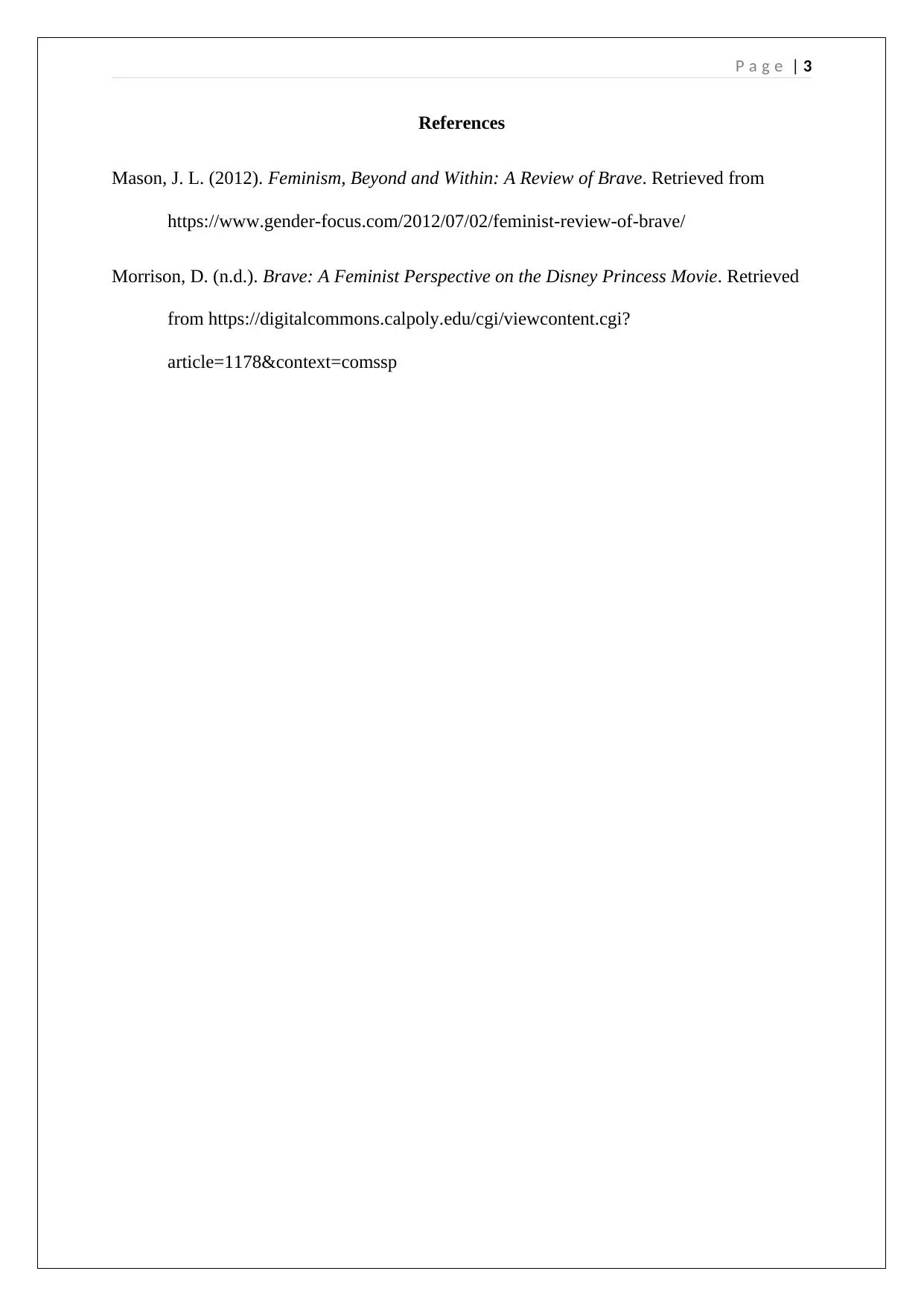Brave Movie Analysis Assignment Report
VerifiedAdded on 2022/09/09
|4
|718
|46
AI Summary
Contribute Materials
Your contribution can guide someone’s learning journey. Share your
documents today.

Student Name
INSTITUTIONAL AFFILIATION(S)
MOVIE ANALYSIS
INSTITUTIONAL AFFILIATION(S)
MOVIE ANALYSIS
Secure Best Marks with AI Grader
Need help grading? Try our AI Grader for instant feedback on your assignments.

P a g e | 1
‘Brave’ movie analysis
Introduction
Brave is one of the great-looking movies which transports its viewers into a fantasy
island with perfect animation, painted thrillingly until the detail is given to every action
performed by Merida with her archery. The movie's director Branda Chapman and Mark
Andrews together with Walt Disney Production uplift a key message regarding
communication made between daughters and mothers. Having flatly rejecting 3 suitors,
Elinor seems happy without a spouse and for Scots, she seems "brave" as she reflected bold
and confident attitude.
Analysis
In masculinity, men are assumed to be competitive, assertive and focused on material
accomplishment whereas women are more inclined towards nurturing family and people.
Contrastingly, feminism in a feminine society reveals more fluid where every gender role is
acclaimed equally. After seeing the movie, ‘Brave’ and reviews about it, it can be said that
the film succeeded or partly succeeded while portraying the tomboyish princess not only
because it was simply a story on a princess but because it was about relationships that took
away the line of focus away from the centre plot. Analyzing sociological and psychological
perspectives, one can relate the incidents of the movie from their own life. But the movie
gave beyond feminist message through Merida's insistence on choosing her destiny and
resistance to being told what to do (Mason, 2012).
Patriarchy is grounded in society making people believe that females are inferior and
must surrender their free will to satisfy men, however, the entire story plot of the movie
centred around fighting such patriarchal note as Merida chooses to fight for her own sake.
She reflects a strong personality that goes beyond domestic and womanly activities which are
‘Brave’ movie analysis
Introduction
Brave is one of the great-looking movies which transports its viewers into a fantasy
island with perfect animation, painted thrillingly until the detail is given to every action
performed by Merida with her archery. The movie's director Branda Chapman and Mark
Andrews together with Walt Disney Production uplift a key message regarding
communication made between daughters and mothers. Having flatly rejecting 3 suitors,
Elinor seems happy without a spouse and for Scots, she seems "brave" as she reflected bold
and confident attitude.
Analysis
In masculinity, men are assumed to be competitive, assertive and focused on material
accomplishment whereas women are more inclined towards nurturing family and people.
Contrastingly, feminism in a feminine society reveals more fluid where every gender role is
acclaimed equally. After seeing the movie, ‘Brave’ and reviews about it, it can be said that
the film succeeded or partly succeeded while portraying the tomboyish princess not only
because it was simply a story on a princess but because it was about relationships that took
away the line of focus away from the centre plot. Analyzing sociological and psychological
perspectives, one can relate the incidents of the movie from their own life. But the movie
gave beyond feminist message through Merida's insistence on choosing her destiny and
resistance to being told what to do (Mason, 2012).
Patriarchy is grounded in society making people believe that females are inferior and
must surrender their free will to satisfy men, however, the entire story plot of the movie
centred around fighting such patriarchal note as Merida chooses to fight for her own sake.
She reflects a strong personality that goes beyond domestic and womanly activities which are

P a g e | 2
often performed by other princesses in Disney movies. Merida is confident and makes
planning and plotting to sneak Elinor out of the castle when she was along with her mother.
Being a feminist believer and self-determined, she insists on taking the lead. Although every
decision does not seem appropriate, yet she was brave enough to make choices rather making
her father tell her what needs to be done. For example, in one of the scenes when she was told
to marry a prince, she asserted “I suppose a princess just does what she’s told?”, representing
a feminist view against the patriarchal status quo (Morrison, n.d.).
Having a positive female and girl's role model is very significant for the society. It
can be said that the movie is quite different from other Disney creations which typically
shows masculinity in them. For example, a male rescuer rescuing a damsel or saving helpless
princesses. The portrayal in Brave goes directly against the stereotype where women are
assumed weak and need male assistance to succeed and survive. The final scene of the movie,
for instance, challenges masculinity believers when Merida grabs her father’s sword and
bravely fights Fergus while rescuing the bear saying firmly, “I’ll not let you kill my mother,”
(Morrison, n.d.).
Conclusion
Brave is all about the dynamic nature of change that needs specialty in relationships
like mother and daughter in the movie who discover the power within themselves by
reflecting action and patience at the same time. Patience and reserve could fit in traditional
gender role movies made for females however Brave challenges the dual idea of society
stating that to fit in the society, one has to take over the other irrespective of gender statuses
like women or men and feminine or masculine.
often performed by other princesses in Disney movies. Merida is confident and makes
planning and plotting to sneak Elinor out of the castle when she was along with her mother.
Being a feminist believer and self-determined, she insists on taking the lead. Although every
decision does not seem appropriate, yet she was brave enough to make choices rather making
her father tell her what needs to be done. For example, in one of the scenes when she was told
to marry a prince, she asserted “I suppose a princess just does what she’s told?”, representing
a feminist view against the patriarchal status quo (Morrison, n.d.).
Having a positive female and girl's role model is very significant for the society. It
can be said that the movie is quite different from other Disney creations which typically
shows masculinity in them. For example, a male rescuer rescuing a damsel or saving helpless
princesses. The portrayal in Brave goes directly against the stereotype where women are
assumed weak and need male assistance to succeed and survive. The final scene of the movie,
for instance, challenges masculinity believers when Merida grabs her father’s sword and
bravely fights Fergus while rescuing the bear saying firmly, “I’ll not let you kill my mother,”
(Morrison, n.d.).
Conclusion
Brave is all about the dynamic nature of change that needs specialty in relationships
like mother and daughter in the movie who discover the power within themselves by
reflecting action and patience at the same time. Patience and reserve could fit in traditional
gender role movies made for females however Brave challenges the dual idea of society
stating that to fit in the society, one has to take over the other irrespective of gender statuses
like women or men and feminine or masculine.

P a g e | 3
References
Mason, J. L. (2012). Feminism, Beyond and Within: A Review of Brave. Retrieved from
https://www.gender-focus.com/2012/07/02/feminist-review-of-brave/
Morrison, D. (n.d.). Brave: A Feminist Perspective on the Disney Princess Movie. Retrieved
from https://digitalcommons.calpoly.edu/cgi/viewcontent.cgi?
article=1178&context=comssp
References
Mason, J. L. (2012). Feminism, Beyond and Within: A Review of Brave. Retrieved from
https://www.gender-focus.com/2012/07/02/feminist-review-of-brave/
Morrison, D. (n.d.). Brave: A Feminist Perspective on the Disney Princess Movie. Retrieved
from https://digitalcommons.calpoly.edu/cgi/viewcontent.cgi?
article=1178&context=comssp
1 out of 4
Your All-in-One AI-Powered Toolkit for Academic Success.
+13062052269
info@desklib.com
Available 24*7 on WhatsApp / Email
![[object Object]](/_next/static/media/star-bottom.7253800d.svg)
Unlock your academic potential
© 2024 | Zucol Services PVT LTD | All rights reserved.